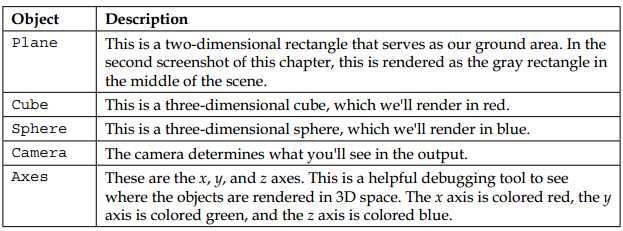标签:elements pos hold dir webgl receive aspect src position
1,各浏览器对WebGL的支持

手机浏览器对WebGL的支持:

书的源码:https://github.com/josdirksen/learning-threejs
第一次用浏览器打开代码可能无法正常显示,好像要对浏览器做一些设置额。
创建第一个3D场景包括这几样东西:

<!DOCTYPE html> <html> <head> <title>Example 01.06 - Screen size change</title> <script type="text/javascript" src="../libs/three.js"></script> <script type="text/javascript" src="../libs/stats.js"></script>//shows the frames per second(fps) for animation <script type="text/javascript" src="../libs/dat.gui.js"></script>//allows you to very easily create a simple user interface component that can change variables in your code <style> body { /* set margin to 0 and overflow to hidden, to go fullscreen */ margin: 0; overflow: hidden; } </style> </head> <body> <div id="Stats-output"> </div> <!-- Div which will hold the Output --> <div id="WebGL-output"> </div> <!-- Javascript code that runs our Three.js examples --> <script type="text/javascript"> var camera; var scene; var renderer; // once everything is loaded, we run our Three.js stuff. function init() { var stats = initStats(); // create a scene, that will hold all our elements such as objects, cameras and lights. scene = new THREE.Scene(); // create a camera, which defines where we‘re looking at. camera = new THREE.PerspectiveCamera(45, window.innerWidth / window.innerHeight, 0.1, 1000); // create a render and set the size renderer = new THREE.WebGLRenderer(); renderer.setClearColor(new THREE.Color(0xEEEEEE, 1.0)); renderer.setSize(window.innerWidth, window.innerHeight); renderer.shadowMapEnabled = true; // create the ground plane var planeGeometry = new THREE.PlaneGeometry(60, 20, 1, 1); var planeMaterial = new THREE.MeshLambertMaterial({color: 0xffffff}); var plane = new THREE.Mesh(planeGeometry, planeMaterial); plane.receiveShadow = true; // rotate and position the plane plane.rotation.x = -0.5 * Math.PI; plane.position.x = 15; plane.position.y = 0; plane.position.z = 0; // add the plane to the scene scene.add(plane); // create a cube var cubeGeometry = new THREE.BoxGeometry(4, 4, 4); var cubeMaterial = new THREE.MeshLambertMaterial({color: 0xff0000}); var cube = new THREE.Mesh(cubeGeometry, cubeMaterial); cube.castShadow = true; // position the cube cube.position.x = -4; cube.position.y = 3; cube.position.z = 0; // add the cube to the scene scene.add(cube); var sphereGeometry = new THREE.SphereGeometry(4, 20, 20); var sphereMaterial = new THREE.MeshLambertMaterial({color: 0x7777ff}); var sphere = new THREE.Mesh(sphereGeometry, sphereMaterial); // position the sphere sphere.position.x = 20; sphere.position.y = 0; sphere.position.z = 2; sphere.castShadow = true; // add the sphere to the scene scene.add(sphere); // position and point the camera to the center of the scene camera.position.x = -30; camera.position.y = 40; camera.position.z = 30; camera.lookAt(scene.position); // add subtle ambient lighting var ambientLight = new THREE.AmbientLight(0x0c0c0c); scene.add(ambientLight); // add spotlight for the shadows var spotLight = new THREE.SpotLight(0xffffff); spotLight.position.set(-40, 60, -10); spotLight.castShadow = true; scene.add(spotLight); // add the output of the renderer to the html element document.getElementById("WebGL-output").appendChild(renderer.domElement); // call the render function var step = 0; var controls = new function () { this.rotationSpeed = 0.02; this.bouncingSpeed = 0.03; }; var gui = new dat.GUI(); gui.add(controls, ‘rotationSpeed‘, 0, 0.5); gui.add(controls, ‘bouncingSpeed‘, 0, 0.5); render(); function render() { stats.update(); // rotate the cube around its axes cube.rotation.x += controls.rotationSpeed; cube.rotation.y += controls.rotationSpeed; cube.rotation.z += controls.rotationSpeed; // bounce the sphere up and down step += controls.bouncingSpeed; sphere.position.x = 20 + ( 10 * (Math.cos(step))); sphere.position.y = 2 + ( 10 * Math.abs(Math.sin(step))); // render using requestAnimationFrame requestAnimationFrame(render); renderer.render(scene, camera); } function initStats() { var stats = new Stats(); stats.setMode(0); // 0: fps, 1: ms // Align top-left stats.domElement.style.position = ‘absolute‘; stats.domElement.style.left = ‘0px‘; stats.domElement.style.top = ‘0px‘; document.getElementById("Stats-output").appendChild(stats.domElement); return stats; } } function onResize() { camera.aspect = window.innerWidth / window.innerHeight; camera.updateProjectionMatrix(); renderer.setSize(window.innerWidth, window.innerHeight); } window.onload = init; // listen to the resize events window.addEventListener(‘resize‘, onResize, false); </script> </body> </html>
Chapter 1:Create You First 3D Scene With Three.js
标签:elements pos hold dir webgl receive aspect src position
原文地址:http://www.cnblogs.com/gester/p/6394885.html